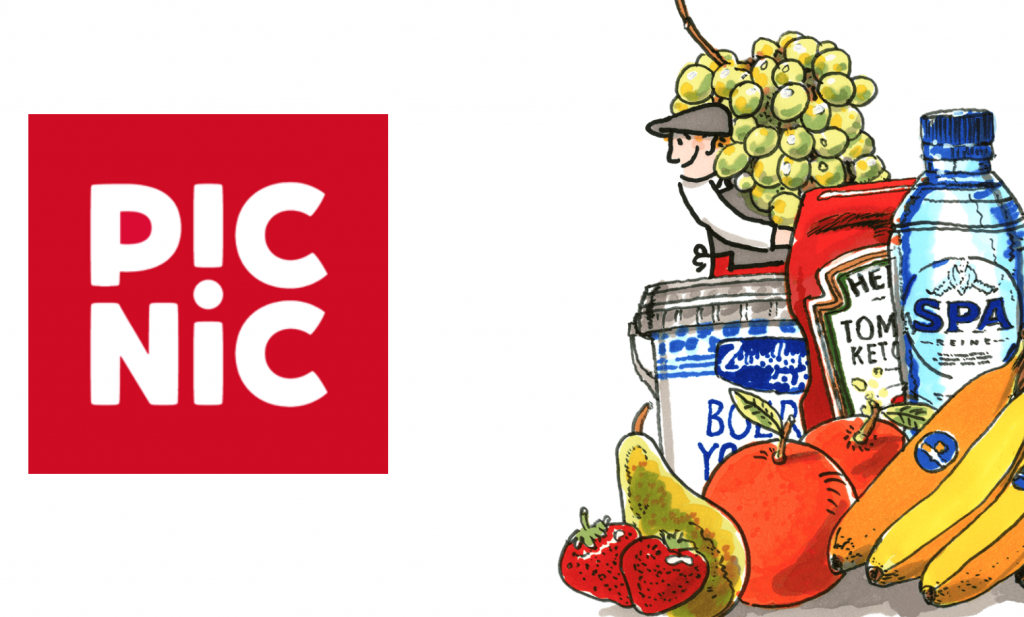In 2015, online supermarket Picnic was founded in The Netherlands. At that time, this business model was very new and innovative for the Dutch Food Retail market. Although the young company is not yet profitable, this online supermarket has grown enormously over the past five years. In 2020, Picnic has approximately 300,000 customers, 4,000 employees and delivers in 125 cities in The Netherlands and Germany (Schelfaut, 2020). It is expected that the company will even further expand and grow in the coming years. Very recently it came out in the news that they will collaborate with the huge German supermarket chain Edeka to create its own private label that is entirely focused on e-commerce in order to achieve even more sales (Business Insider, 2020). With special logarithms, Picnic is able to drive efficient routes in order to save costs and for sustainability purposes. Furthermore, they strive to deliver on time and to be customer friendly (Van Tatenhove, 2018). Based on these insights, it seems that Picnic is a success story and that it can be regarded as a threat for incumbent firms.
However, the competition in the food retail e-commerce has grown in recent years.
Existing physical supermarket chains, such as Albert Heijn and Jumbo, started offering online delivery services as well. Picnic has had a competitive advantage over these supermarket chains for a long time because of its low costs, free delivery and customer centric commerce (Business Insider, 2015). They distinguished themselves as ”the modern milkman” to transform the way people do their groceries (Van Tatenhove, 2018).
However, Albert Heijn for instance has also improved their online service due to the high demand and sales for online grocery delivery. They have reduced their minimum order amount and also set up more hubs across the country in order to be able to deliver even faster (AH, 2019). About two weeks ago, Albert Heijn launched a grocery delivery service application that is very similar to Picnic: Albert Heijn Compact. With this concept, AH delivers groceries free of charge at home, the minimum order amount is the same as that of Picnic and the functionalities of the app are practically the same (Van Woensel Kooy, 2020). This could be a threat to Picnic, as Albert Heijn has a long history, strong reputation, large customer base and much capital. Additionally, another growing online supermarket was introduced in 2018, named Crisp, which focuses on fresh, local food delivery (Crisp, 2020).
As a result of these new entrants in the industry, competition is increasing. Picnic is no longer the only online supermarket in the Netherlands and runs the risk of losing customers to competitors. Furthermore, the turnover of incumbent supermarket chains remains stable, despite the entrance of potential disruptor Picnic (Smit, 2020).
Based on these insights, I wonder whether Picnic is as disruptive as was thought a number of years ago? Is Picnic not at risk of being overshadowed by a newcomer to the market that incorporates even more advanced technologies and really overtakes the existing markets?
Perhaps in future consumers will only have to name what they need, and it will then automatically be ordered for you and delivered within a short period of time?
I look forward to reading your views on this.
References
AH. (2019). AH kondigt 5e Home Shop Center aan om forse online groei bij te benen. [Online] Available at: https://nieuws.ah.nl/ah-kondigt-5e-home-shop-center-aan-om-forse-online-groei-bij-te-benen/ [Accessed 4 October 2020]
Business Insider. (2015). Dit doet de nieuwe websuper Picnic anders dan Albert Heijn en Jumbo. [Online] Available at: https://www.businessinsider.nl/picnic-online-supermarkt-albert-heijn-jumbo-591766/ [Accessed 4 October 2020]
Business Insider. (2020). Websuper Picnic komt met een eigen huismerk – omdat alles online wordt verkocht zijn de verpakkingen anders dan normaal. [Online] Available at: https://www.businessinsider.nl/online-supermarkt-picnic-huismerk-verkopen/ [Accessed 4 October 2020]
Crisp. (2020). De supermarkt-app voor knettervers eten. [Online] Available at: https://www.crisp.nl/ [Accessed 5 October 2020]
Schelfaut, S. (2020). Picnic breidt capaciteit flink uit na explosieve groei online boodschappen. [Online] Available at: https://www.ad.nl/koken-en-eten/picnic-breidt-capaciteit-flink-uit-na-explosieve-groei-online boodschappen~a872e4a9/#:~:text=Wij%20verwachten%20de%20komende%20weken,mensen%20aan%20te%20nemen.”&text=Het%20bedrijf%20telt%20nu%20zo,klanten%20en%20ruim%204000%20medewerkers [Accessed 4 October 2020]
Smit, P. (2020). Marktaandeel Albert Heijn stabiel op 34.9%. Available at: https://www.nieuweoogst.nl/nieuws/2020/01/21/marktaandeel-albert-heijn-stabiel-op-349-procent [Accessed 5 October 2020]
Van Tatenhove, J. (2018). Picnic: the modern milkman transforming urban distribution. [Online] Available at: https://medium.com/lifes-a-picnic/picnic-the-modern-milkman-transforming-urban-distribution-bae975749a12 [Accessed 4 October 2020]
Van Woensel Kooy, P. (2020). Albert Heijn gaat vol door op online markt. [Online] Available at: https://www.marketingtribune.nl/food-en-retail/nieuws/2020/09/albert-heijn-gaat-vol-door-op-online-markt/index.xml [Accessed 2020]


